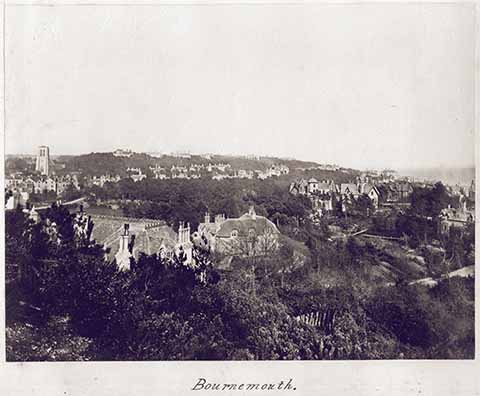The house that Lewis built
Roger Guttridge questions the dating of Bournemouth’s origins as a seaside resort
Published in January ’19
Read any history of Bournemouth and it will give what is effectively the seaside town’s birthday as 14 July 1810. That is the date when the celebrated ‘Founder of Bournemouth’, Lewis Tregonwell, and his wife, Henrietta, are supposed to have made their inaugural visit to uninhabited ‘Bourne’ during a holiday at Mudeford. The books also tell us that the first sale of land to Captain Tregonwell was completed on 25 September 1810, that building work on his seaside mansion began in 1811 and that the house was ‘ready for occupation’ early in 1812.
But at least some of these details of Bournemouth’s early history may need tweaking. For little-known diaries from the period suggest that events unfolded slightly earlier than traditionally believed. In her diary, Tregonwell family friend Harriet Grove writes of her own family’s stay at Mudeford in July 1810. Her entry for 4 July reads: ‘We all walked on the sands. The Tregonwells are here and very kind to us. We went after dinner to see a place Mr T has bought and talks of building on called Bourne. It is very barren but a pretty sea view.’ This clearly suggests that not only the Tregonwells’ historic first visit but the land purchase were done and dusted at least ten days before 14 July – and presumably a good bit before that.
The two families met several more times during their July 1810 stay at Mudeford, visiting Hordle Cliff in the Tregonwell carriage on 7 July and ‘the Lookout’ on 8 July. On 9 July, Harriet wrote: ‘The Tregonwells left us, which we are very sorry [about]. Walked with Helen [the Tregonwells’ daughter] on the sands before she went.’
Helen was a lifelong friend of Harriet’s sister, Charlotte, whose own diaries repeatedly refer to her and the Tregonwells. Charlotte herself appears to suggest that the Tregonwell mansion was already standing in May 1811, a year or so before the completion date given by other sources. In her diary entry for 30 May 1811, she writes: ‘A party of pleasure to Bourne Cliff. Mr Tregonwell’s new house – dined on cold meat in the house. St Barbe [the Tregonwells’ son] walked through a brook eight times to help us over. Mrs Portman and the Miss[es] Williams met us at Bourne. The seashore there beautiful.’
The ‘brook’ was presumably the Bourne Stream that today bisects the Bournemouth Gardens. Mrs Portman was probably a relative, as Henrietta Tregonwell was a member of the Portman family from Bryanston. But Charlotte Grove’s comment about dining at ‘Mr Tregonwell’s new house’ in 1811 appears to conflict with Henrietta’s own diary entry for 24 April 1812, where she records that they ‘Went to Bourne: slept there for the first time’.
Henrietta’s diary appears to be the original source for all traditional datings. Charles H. Mate and Charles Riddle quoted it in their history of early Bournemouth, published in 1910 to mark the town’s centenary. According to them, Henrietta referred to visits on 14 and 30 July 1810 and ‘further and frequent visits’ in September, October, November and December. Mate and Riddle continue: ‘There was much going to and fro again in March and April 1811; in June they came over from Christchurch every day for a week – a fact significant not of pleasure-taking alone, but of business. The erection of “the Mansion” had been determined upon and commenced. But apparently it was not completed till the spring of the following year, for the entry in Mrs Tregonwell’s diary under the date 24 April 1812, reads…’ They then quote Henrietta’s comment about sleeping in the house for the first time. The most significant word here is ‘apparently’. Although later writers have taken 1812 as the definitive date of occupation, Mate and Riddle clearly had their doubts.
There is more than one possible explanation for the apparent contradiction. Perhaps the mansion was completed the previous year and 24 April 1812 was no more and no less than Henrietta said it was – the date that they first spent the night there. Or perhaps Charlotte Grove was referring to a different building. Before constructing his mansion, Tregonwell built a thatched cottage nearby to house his butler, Symes. This was called Portman Lodge and is thought to have been completed in 1810. Could it have been at Portman Lodge rather than the mansion that the Tregonwells and the Groves dined on 30 May 1811?
In other words, the Tregonwells’ active interest in the Bourne site predated 14 July 1810. Harriet Grove’s 1810 entries make that abundantly clear.
The Grove family lived at Fearne House, Berwick St John, near Shaftesbury. Harriet’s diary is actually owned by the New York Public Library and was published in 1961 in a book about the poet Percy Bysshe Shelley, her cousin and first love. But the American editor of that volume misread ‘Bourn’ as ‘Cairn’ so the link with Bournemouth remained undiscovered until the late Desmond Hawkins of Blandford flew to New York in the 1990s to read the original. Harriet’s and Charlotte’s diaries are among several featured in Mr Hawkins’s book The Grove Diaries: The Rise and Fall of an English Family 1809-1925, published by Dovecote Press.
The Tregonwell mansion later became known as Exeter House and survives as part of the Royal Exeter Hotel. Portman Lodge was badly damaged by fire in 1922, rebuilt but then demolished in 1930.


